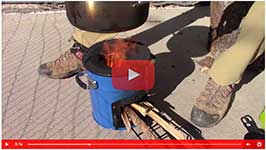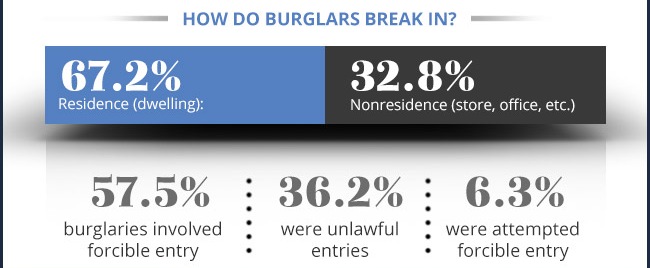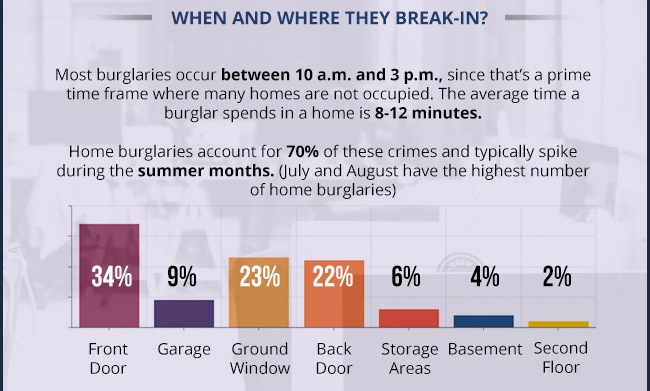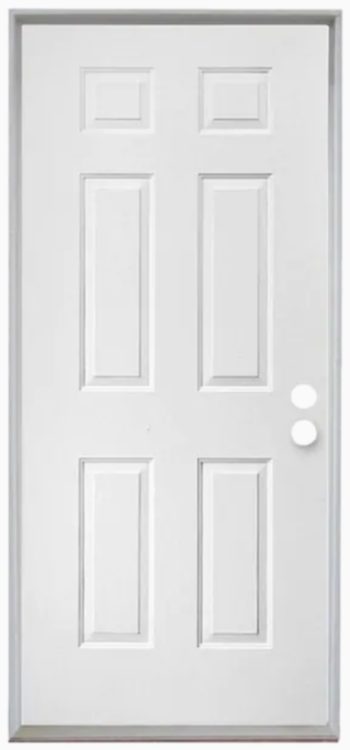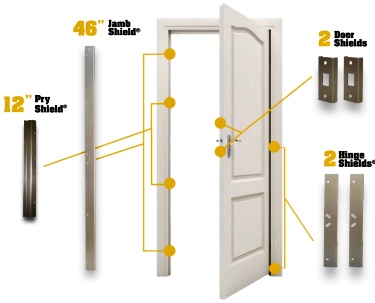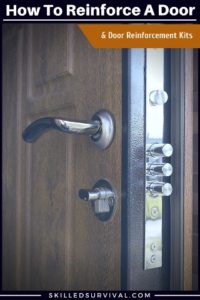
Because let’s face it: doors are the most vulnerable part of your home’s security. Want proof? Just check the number of break-ins that happen through doors.
Yet, for some reason, upgrading your door is often one of the last things people think about. And when they do, they usually make mistakes that make their efforts useless.
But don’t worry — today, I’ll show you how to upgrade your door the right way!

Want a free 78 item bug out bag checklist?
Enter your email below to instantly download this Complete Checklist PDF. No purchase necessary. 👇 👇Why You Should Reinforce Your Exterior Doors
Movies influence how we think about reality. Hollywood is NOT reality. This influence is especially true when it comes to home invasions.
- Action movies show thieves hatching elaborate plans to trick complex security systems.
- OR they feature Ninjas scaling up walls to second-floor windows to cut glass and unlock it.
In reality, most intruders avoid complex maneuvers. Instead, the “pros” opt for lower-risk break-ins. They prefer quick and easy. They want a fast “smash and grab.” Something they can pull off with nearly zero risk of getting caught.
↓ Burglar Explains How He Breaks Into Homes
For example: Kicking in a cheap door or smashing a back window lets them escape prying eyes sooner. That’s why most home intrusions involve forced entry through an unsecured door. Data proves this number might be high as 85%.
The first thing to notice is that most break-ins occur at home residences (67.2%).
Next, most involved forcible entry (57.5%) and 88% of break-ins occur on the ground floor. And only 6.3% of the break-ins fall into the “attempted” category.
↓ Burglars Caught On Camera Breaking Into Home
What This Data Means
I interpret this as most break-ins involve forced entry, and most are successful (for the thief). I also see the 36.2% unlawful entries as likely “unforced entry” through unsecured doors.
These often include garage side doors and backyard doors. Why? Because these “alternative entry points” are often overlooked when the occupants leave. And they’re also less likely to be built to the same security standards as your front door.
I’ll be honest:
Occasionally, I’ve forgotten to lock my back garage door after a long day of yard work. And I only realized my mistake later the next day.
ANYONE could have walked through my backyard door and right into my house. Oops! It’s NOT a warm and fuzzy feeling!
Now, what about the hype around home security alarm systems? The ones that alert you (and the authorities) if someone opens a door or window.
They’re undoubtedly a great addition to anyone’s home fortification strategy. But these expensive security systems are reactive, NOT preventative.
They only let you know that SOMETHING BAD IS ALREADY HAPPENING! And thus, can create a false sense of security.
And too many people ignore other necessary home security improvements – like exterior doors.
ALL exterior first-floor doors should be the first place to spend your time and attention.
If your doors look well-built and secure, a burglar might not even attempt to break in. It’s a real-life strategy called target hardening.
If a door looks resilient and has no cover (bushes/fence) nearby, it becomes risky for an intruder to attempt a break-in. And like lions looking for a quick meal, thieves also tend to gravitate towards weaker prey.
For an intruder, it’s all about ease and cover.
Experienced intruders will avoid extra obstacles and seek easier prey. And if they still decide to give it a go, a reinforced door will delay entry. And it will deter all but the most stubborn of thieves.
With Door Reinforcement, Construction Matters
Before reinforcing any door, you must ensure the door itself isn’t “the weak link.” So let’s cover different door construction options and the pros/cons of each:
Hollow Core Door
I can’t tell you how many student rentals I’ve seen with flimsy interior doors.
All too often, people use these cheap doors to secure garages, backdoors, and even some front doors!
The majority of these flimsy doors are of the hollow-core variety.
These doors have an exterior wood frame. And this frame supports an interior honeycomb structure of fiberboard. And then, the entire assembly gets covered in thin sheets of veneer wood to make it “look good.”
The cores of these doors usually use cheap fiberboard – or occasionally cardboard! Yes, cardboard!
These doors are light, cheap, and available at ANY hardware store. And they’re perfect for many interior spaces, like a bedroom closet. But NOT for an exterior door where security matters!
Why? Because any drunk college student can bust right through a hollow-core door. I’ve seen it with my own eyes… And that’s why they won’t stop a criminal either.
Solid Core Door
A solid-core door is a slight upgrade over a hollow-core door.
How? The honeycomb structure on the inside uses a particleboard core.
This material upgrade tends to make them a bit heavier. That’s why these doors have a solid feel and better sound deadening.
However, again, you should only install them in interior settings. Why? Because, like hollow-core doors, particleboard readily absorbs water from rain and snow and… swells.
And swelling forces the door out of the jamb, making it hard to close the latch properly. And if these doors remain wet for too long, the particle board starts to disintegrate.
This process will continue until the door completely fails. Again, a cheap solution like this will cost you more in the long run.
Solid Wood Door
A step up from the solid core door is a solid wood door.
These doors start and end with solid wood boards. Those boards are then joined together with glue and fasteners.
This strategy produces a stronger door than hollow or solid core doors. And that’s why solid wood doors can be quite expensive.
Not only are they ideal for security, but they also look good on a home’s exterior.
Any exterior location demands unique patterns and finishes to match different home décor.
Many exterior solid wood doors include designer windows and other decorative features.
A well-built solid wood door can last a long time. But they also take regular maintenance and protection from the elements.
The interior of a solid wood door is often at least as strong, if not stronger, than the surrounding door frame.
This strength makes them the minimum you want for an exterior door.
Insulated Metal Door
Finally, the most common type of modern exterior door is an insulated metal door.
These doors feature an insulated core surrounded by metal panels on the exterior.
Some even have extra metal panels within the interior as well.
These panels are often decorative, with textures and design elements.
Many emulate a solid wood door construction, including windows and “raised panel” details.
Insulated metal doors are very resistant to the elements AND forced entry attempts. So they’re a great choice if you’re replacing older doors and want to beef up security.
Of course, they come at a cost premium, so budget for the upgrade.
Doors With Windows
No doubt, the addition of windows can be a beautiful aesthetic.
But they can also add significant security risks. Why? Because even the most secure door is worthless if a burglar can smash a window and reach the door lock.
This security vulnerability is worse if you have windows within arm’s reach of the door lock.
In that case, replacing them with security glass or polycarbonate may be worth it. In higher crime areas, window bars or grates are also an option. But local laws may restrict what windows you can cover, and they’re not pretty to look at either.

Want a free 78 item preppers checklist?
Enter your email below to instantly download this Complete Checklist PDF. No purchase necessary. 👇 👇How to Reinforce A Door Frame
No lock in the world can stop a persistent intruder IF the door latches into a cheap frame.
Luckily, you can reinforce a door frame in several ways to make it more resistant to attacks.
Longer Screws
One of the easiest upgrades to any exterior door is to replace the short screws that come with it.
Unfortunately, manufacturers ship many exterior doors with short 2″ hinge screws.
2″ IS NOT deep enough for security!
Ideally, you want the screws to go through the hinge plate, door frame, and into the structure of the building. So I recommend you remove one of these screws and buy similar screws that are 4″ in length.
Make sure to buy enough to replace ALL the screws in the door’s hinges.
Now, once back home, replace each screw one at a time. This strategy prevents the hinges from shifting and causes the door to bind or squeak.
Door Reinforcement Kits
Another method is investing in a door reinforcement kit.
I like this one from Armor Concepts.
I believe this kit is the best on the market. It protects both the doorknob lock and the deadbolt.
Plus, it protects the hinges and the door frame against drilling and prying!
It’s a massive upgrade to the structure of the door frame. This modification will give you extreme peace of mind.
Now you KNOW the frame is as durable as the door itself. Again, Armor Concepts is the door reinforcement company we recommend.
Their kits have stood up insanely well to intense police force testing; watch the video below for proof:
↓ Door Armor Independent Security Testing
Not only that, but each kit offers a lifetime warranty. Plus, they include a $500 guarantee against door kick-ins.
You can even use their security kits to help repair previous door frame damage!
Here’s a video showing the installation of an Armor Concepts Door Reinforcement Kit:
↓ Armor Concepts Door Armor Review | Home Preps
Alternate Ways To Reinforce A Door
Once you’ve got solid doors on all the exterior doorways, it’s time to increase the security even more. Your chosen methods for adding security are often driven by whether you own or rent.
A homeowner can usually make extensive modifications (within local building codes). But if you rent, you’ll likely need a landlord’s permission to make ANY changes.
And your lease agreement may prevent you from reinforcing doors or changing locks. But it’s always wise to approach home security in a multi-layered strategy.
So let’s examine a range of security upgrades you can add in stages. We’ll start with the easiest upgrades first. They are the ones that apply to both rentals and homeownership.
Then we’ll work towards more involved security upgrades for homeowners – the ones you may want to hire a skilled handyman to perform.
Door Stop Alarm
The most widely accessible home security upgrade is the addition of a doorstop alarm.
These wedge-shaped doorstops do a decent job of blocking a door from being forced open. But they also include an ear-piercing alarm system!
If an intruder pushes on the door hard enough to force the doorstop to slip, it triggers a loud 120dB alarm.
It’s not a door reinforcement upgrade, and it’s cumbersome to set each time you leave home. But for about $5 each, you can afford to put one at every door.
Plus, they don’t require any installation or wiring. So door stop alarms are especially useful in rental security situations.
Door Jammer
Another simple physical blocking device is a door jammer.
These devices work for both hinged and sliding doors to prevent break-ins. And some of the door jammer models also come with audible alarms built-in.
Plus, they’re both adjustable and portable. So any jammer will fit a wide range of doors and can take them with you if you move (or even when traveling).
Like the door stop alarm, door jammers are simple to install. And you can place them without ANY modifications to the home, so they’re ideal for renters.
Security Peephole
What’s one of the most vulnerable situations for forced entry?
It’s when an occupant cracks open the door to see who’s on the other side.
Yes, security chains do provide some protection for this. But it’s far better to leave the door shut until you can determine the risk of the situation.
A peephole is a far better option.
These holes allow you to leave your door closed and secure until you can confirm it’s safe to open.
Make sure you choose a peephole with a wide viewing angle and a privacy cover on the inside lens.
These features help prevent anyone from peeping back in at YOU.
Now, adding a peephole does require drilling through the door.
So double-check your placement before you drill. OR hire someone to install it IF you don’t have the skills or tools to DIY.
This concern is even more critical if the door is metal (more complex than wood)!
Video Doorbells
A video doorbell system allows you to check who’s at the door without even being in the room.
They can alert you via text message or smartphone app to movement outside your door. And even record videos and images of anyone (or anything) approaching.
Now, there are options to install these units without wiring. But the best method is to tie them to existing low-voltage doorbell systems.
That way, the video doorbell, and the app will ring anytime someone presses the button.
Rekeyed Locks
If you’ve recently purchased or leased a new home, it’s worth seeing if you can have the doors rekeyed. Why? Because previous residents likely made several sets of spare keys in the past.
And leaving the original lock means they could stroll back in any time they please. And rekeying is less expensive than replacing the locks.
One convenient way to rekey is to buy a rekeying kit.
This kit allows you to rekey all your locks to one pre-cut key.
It includes 3 pre-cut keys, pins, special tools, and simple-to-follow instructions.
This kit makes re-keying your locks easy; even a novice can complete the DIY task.
Rekeying kits require the original key to be rekeyed as part of the re-keying process.
Deadbolts

They help to slow down and deter intruders using a solid single-cylinder deadbolt. Why? Because the tapered latch on a standard doorknob lock is quite easy to defeat.
A thief can easily bypass these standard doorknobs. They can shim the door or spread it with a hydraulic jack. But a properly installed deadbolt extends at least an inch into the latch plate.
And door frames are usually less vulnerable to the same “force-based attacks – especially if it’s a reinforced door frame.
If you want to DIY a new deadbolt, there are lock-install tools that can help align the holes. But for most, it’s best left to an experienced locksmith.
Electronic & Smart Locks
Rekeying or adding new locks and deadbolts is great. But they don’t do much good if you forget to lock them. Or you have to leave a spare key outside for the house-sitter while you’re on vacation.
An electronic keyless lock allows you to lock or unlock your door from anywhere via your phone.
You can even set temporary keypad codes to allow guests access for a limited time.
They’re a simple drop-in replacement for many existing deadbolts or locksets. But if you plan on installing an electronic lock from scratch, consider using a locksmith.

Want a free 78 item preppers checklist?
Enter your email below to instantly download this Complete Checklist PDF. No purchase necessary. 👇 👇Security & Reinforcement Strategies For Garage Doors
So far, we’ve primarily focused on reinforcing standard entryway doors. But it’s important to remember that garage doors can also be a natural entry point for burglars.
Older garage doors can be vulnerable to many of the same attacks that plague entryway doors. To prevent garage break-ins (or worse, if you have an attached garage), here are a few more tips:
Keep Some Light On It – Motion Lights
Keeping a security light (or motion light) pointed at the garage is an excellent way to deter thieves.
Most thieves prefer to work in the cover of darkness.
Prune Back The Hedges
Keeping landscaping away from the doors doesn’t leave anywhere to hide.
It forces them out in the open while trying to scope or break into your garage or shed.
Keep The Door Closed
Leaving the doors open for a breeze is tempting if you work in the garage.
Unfortunately, that also gives passers-by a chance to see what you have.
OR to grab and run when if you’re not around.
Keep the doors closed, even if you’ll be right back out to work.
Secure Your Doors
Like entryway doors, garage doors come in several levels of quality – each having a different resistance to break-ins.
Go for an insulated roll-up metal door, and lock it when you are away.
Use A Garage Door Opener
An electronic garage door system helps you open and close the door as needed.
This feature ends the cumbersome activity of manually opening and closing your garage door. So you have zero excuses to leave it open for long periods.
It also provides a solid block against anyone rolling the door up.
Electric garage door openers also use a lift mechanism that resists manual motion.
Modern garage door openers can also connect to smartphone apps. These can alert you to an open door and enable you to close it remotely.
Install A Keypad
Again, an electronic keypad can provide access for a guest or worker. And they also allow lockdown after use to prevent a guest from returning with an outdated access code.
DIY Door Reinforcement Project
In the case of DIY Door Reinforecment, a video does a much better job than a bunch of words:
↓ Make Your Doors Secure With This Easy Trick
Final Thoughts
We don’t always consider the door a high-security line of defense. But it’s the only thing standing between our house and an intruder. A secure and reinforced door can deter interest and resist attacks.
They’re an excellent investment because they keep your family and belongings safe. With such a wide range of security upgrades, the best approach is multi-layered.
You can always add additional security as needed, but the worst time to do so is AFTER a home invasion, so don’t delay! Put your door reinforcement plan into action TODAY!

Prepare, Adapt & Overcome,
P.s. - I just found out 2 out of 3 Americans don’t feel prepared for a 3 day disaster!!!
I guess this goes to show how modern society continues to embrace ‘living a fragile life.’ What’s crazy is… it’s so easy to fix.
To make sure YOU have the basics, watch our FREE training on “10 Simple Steps To Basic Preparedness” that shows you HOW.
Nothing crazy here… this isn’t doomsday prepping... just the basics every responsible adult should have before a disaster strikes.Why You Can Trust Skilled Survival...
Go here now to review a full breakdown of:
- Who We Are
- Our Credentials
- Our Mission
- & Product Recommendations...
Here are a few highlights of our teams credentials & certifications:
- Certified Member of a Mountain Search & Rescue Organization
- Plant Emergency & Safety Leader for a Major Food Manufacturer
- Member of the 10TH Mountain Division Hut Association
- Certifications: Avalanche 1, WFR, CPR
- Official Gear Tester for Numerous Outdoor Gear Companies
- Countless Multiday Backpacking trips into Remote Wilderness
- Bachelor's Degree In Mechanical Engineering
- Bachelor's Degree In Civil Engineering
- Bachelor's Degree In Biomedical Engineering
"It takes 20 years to build a reputation and five minutes to ruin it." - Warren Buffett
We're fully aware that trust is NOT something you GET but is EARNED.
And we'll continue to earn YOUR trust through our forthright and honest approach with each new Blog Post, Guide & Product we create...
P.s - I just took this FREE 60-second 'Readiness Score Quiz'👇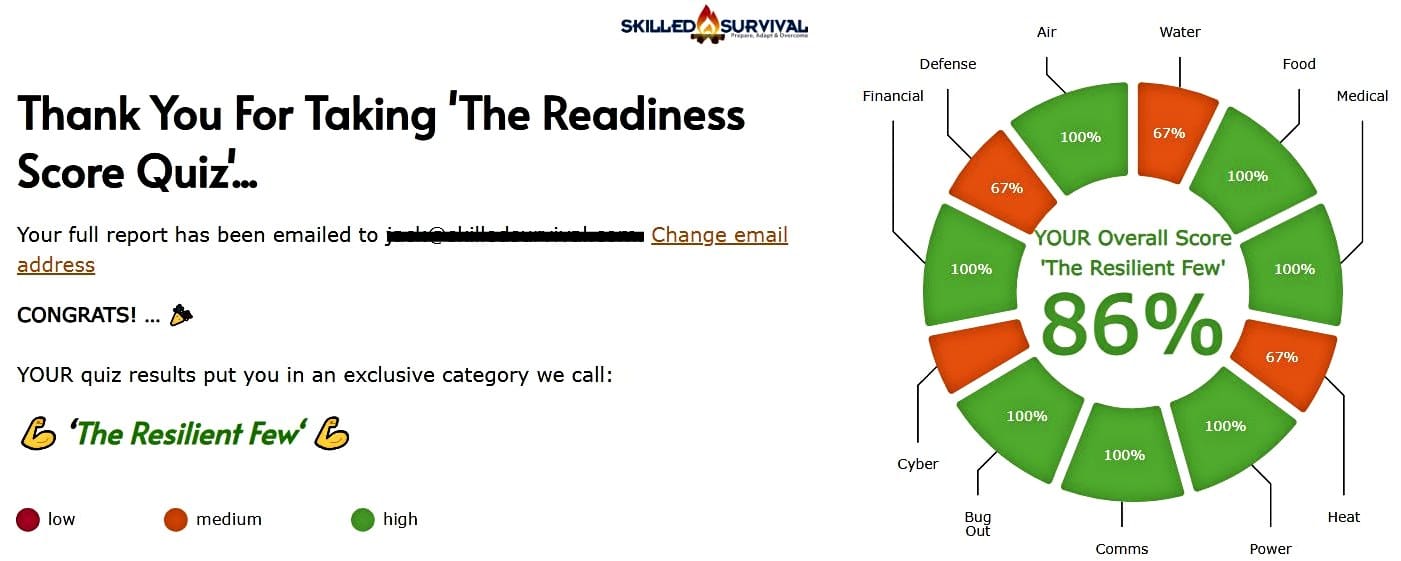
AND... I've still got a few gaps in my preps...🤔 But at least, I'm not part of 'The Fragile Masses'. 👍 Find out where YOU stand by answering a few questions...
